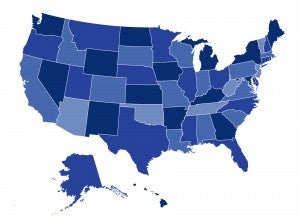
In our most recent issue brief for the Commonwealth Fund, we turn to state implementation of the Affordable Care Act’s most significant reforms and regulators’ ability to enforce these new protections. The issue brief is part of an ongoing series by CHIR on implementation of the Affordable Care Act in all 50 states and the District of Columbia. (Learn more about our project here.)
What does the ACA do? The Affordable Care Act includes numerous consumer protections designed to improve the accessibility, adequacy, and affordability of private health insurance. Beginning in 2014, the law ushers in significant changes for insurers that sell coverage in the individual and small group markets, both inside and outside of the exchange. These protections include guaranteed issue; restrictions on the factors that insurers can consider when setting premiums; a prohibition on preexisting condition exclusions; coverage of a defined set of essential health benefits; and limits on out-of-pocket costs for consumers; among others.
What did we find? Only 11 states and the District of Columbia have passed laws or issued regulations to implement the Affordable Care Act’s most significant reforms that go into effect in 2014. Thirty-nine states have not yet taken action to implement these requirements, potentially limiting their ability to fully enforce the new reforms and help ensure that consumers receive the full protections of the law. Based on a review of actions taken by states and the District of Columbia to implement the 2014 reforms between January 1, 2010 and October 1, 2012, we found that states took the following steps:
- One state, Connecticut, passed legislation that addressed all seven of the new reforms.
- Another state, California, passed legislation on six of the seven reforms.
- Nine states—Arkansas, Maine, Maryland, New York, Oregon, Rhode Island, Utah, Vermont, and Washington—and the District of Columbia passed laws or issued new regulations covering at least one of the seven new market reforms.
To understand whether states did not take action because regulators have existing authority to enforce federal law (through, for example, a broad provision that allows the insurance department to enforce federal insurance protections), we also surveyed state regulators about their legal authority to enforce and write new rules regarding the 2014 market reforms. We found that—without new legislation—regulators in at least 22 states would be limited in their ability to use all of the tools they need to protect consumers under the Affordable Care Act.
What do the findings mean? Our findings suggest that future state action is critical for policymakers who wish to limit direct federal enforcement of the reforms and for consumers expecting to benefit from these new protections. Implementation will be especially important because regulators in at least 22 states reported that they would be limited in their ability to use all of the tools they need to protect consumers without new legislation. While states can use existing authority to promote compliance with many of the law’s requirements, questions remain about how effectively states can enforce the 2014 market reforms without new or expanded legal authority.
In states that do not take new action, additional coordination may be required between state and federal regulators to address enforcement gaps. As states contemplate new action, they are likely to look to how federal regulators define what it means for a state to “substantially enforce” these reforms, and whether this standard will demand that states have explicit enforcement authority. Indeed, state regulators that moved forward with implementation cited the importance of making it explicit to insurers and the federal government that the state has the authority to enforce the Affordable Care Act.
We expect additional state action in 2013 and will keep you updated at CHIRblog as bills move forward in state legislatures across the country. For our first installment of state legislation on the 2014 market reforms and state enforcement authority, check out this blog. We are already beginning to see bills in Oklahoma, Virginia, and other states, many of which have been introduced by Republican legislators.
The issue brief follows our previous issue briefs on state action on the early market reforms (which include new consumer protections such as dependent coverage up to age 26 and the coverage of preventive services without cost-sharing) and the availability of child-only coverage. Stay tuned for our forthcoming issue brief on state implementation of the Affordable Care Act’s new health insurance exchanges!
And, for more information on reports like these, be sure to check in with CHIRblog where we’ll keep you updated on our research and everything you need to know about the “State of the States.”

